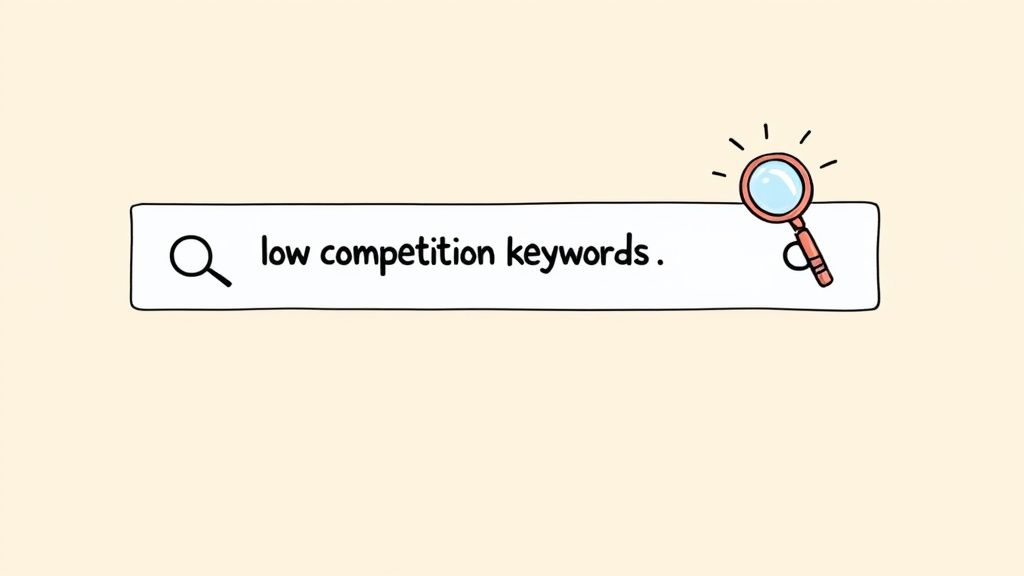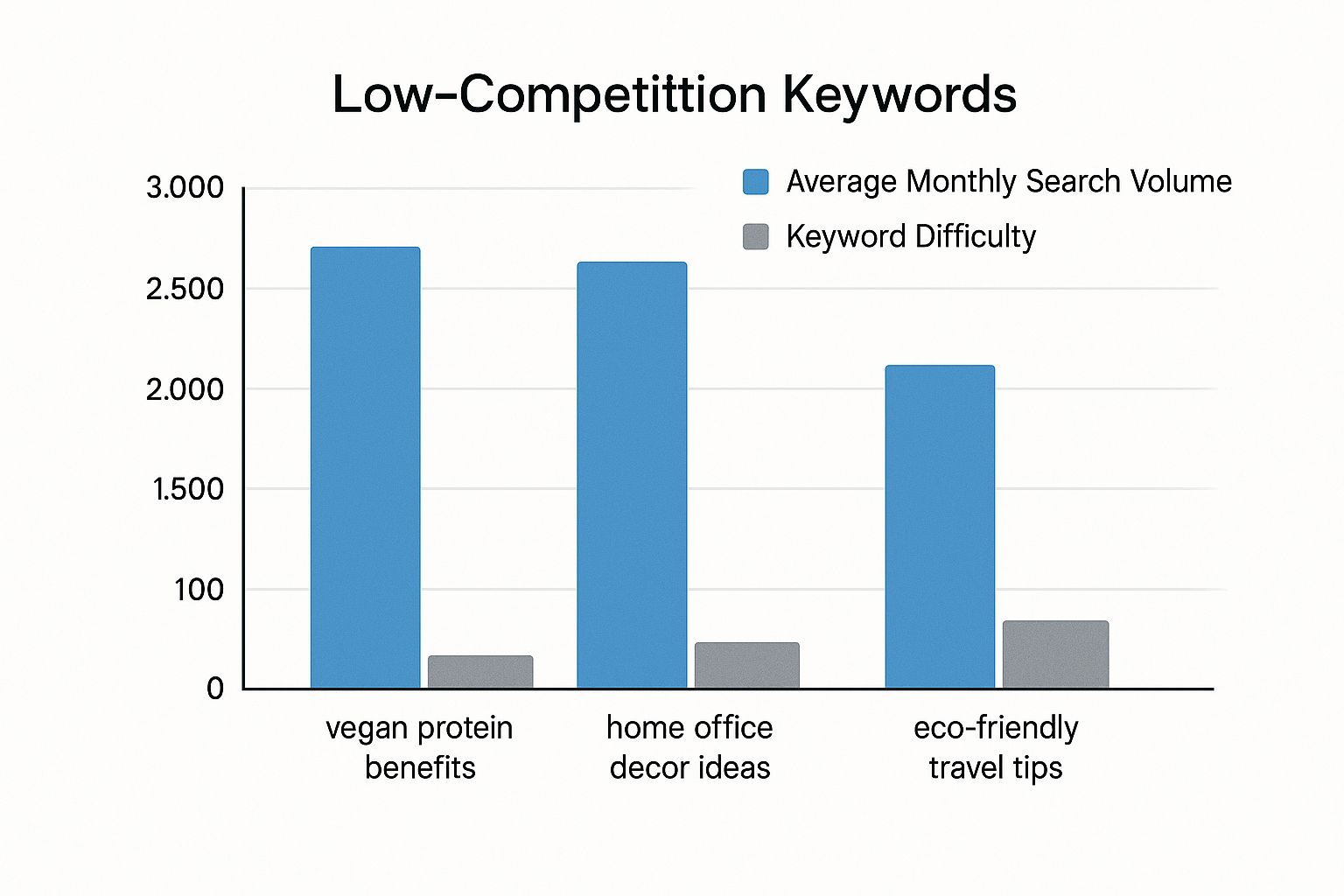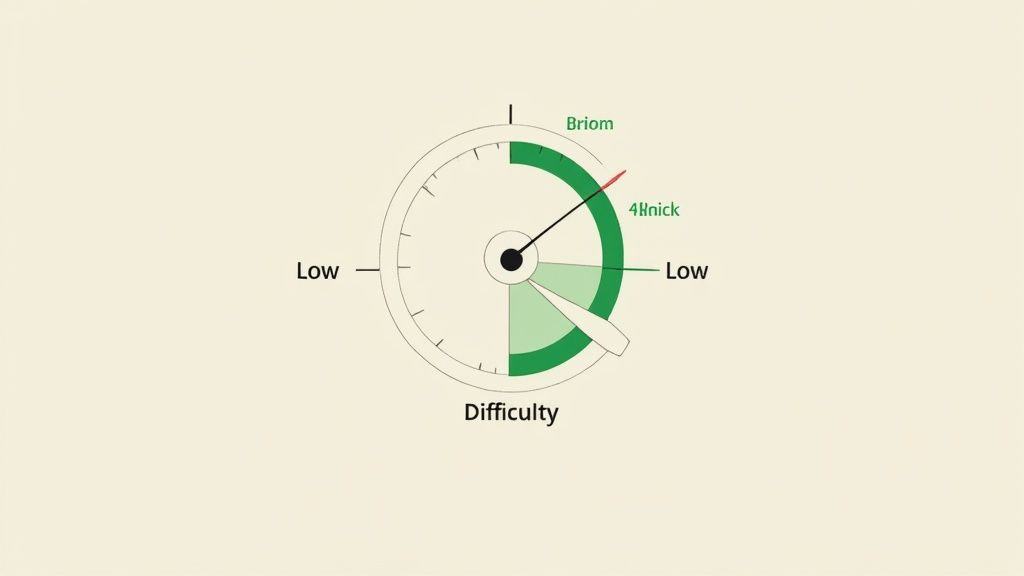
Find Low Competition Keywords That Actually Rank
Sections
- Why Most Keyword Research Strategies Fall Flat
- Reading The Real Competition Landscape
- The Long-Tail Strategy That Changes Everything
- Tools and Techniques That Actually Deliver Results
- Validation Methods That Prevent Expensive Mistakes
- Building Your Strategic Keyword Portfolio
- Your Keyword Success Action Plan
#Why Most Keyword Research Strategies Fall Flat

Let’s be honest, most keyword research strategies miss the mark. People get laser-focused on high-volume keywords, thinking they’re the key to online success. But these keywords are usually dominated by giant websites with tons of authority. It’s like a David and Goliath situation, but without the slingshot. I’ve seen countless SEO pros fall into this trap.
This fixation on high volume comes from a misunderstanding of how keyword competition really works. Most keyword tools give you a simple difficulty score, but that’s rarely the whole picture. A keyword with a difficulty of 30 can be way tougher to rank for than one with a difficulty of 50, depending on who you’re up against. Things like content quality, backlink profiles, and website authority are huge factors, and they often get ignored.
Plus, the allure of massive search volume is a real head-fake. It’s easy to get drawn in by the promise of thousands of visitors. But what’s the point of all that traffic if nobody’s buying?
#The Power of Long-Tail Keywords
This is where long-tail keywords come in. These longer, more specific searches might have less volume individually, but they attract a highly targeted audience ready to spend money. Think about it: someone searching for “best Italian restaurants near me open now” is much closer to becoming a customer than someone just searching for “restaurants.”
Look at the numbers: studies show that 70-80% of searches are long-tail. Google processes about 8.5 billion searches per day in major English-speaking markets like the US, UK, and Australia. But less than 20% of those are for super-competitive terms. Check out some more insights on keyword trends.
Focusing on long-tail keywords, where the majority of searches actually happen, lets you tap into a huge pool of potential customers actively searching for exactly what you offer. This not only makes finding low-competition keywords easier, but it also makes sure the traffic you get is high-quality and ready to convert.
#Reading The Real Competition Landscape
Keyword research tools like Semrush are fantastic, but let’s be real, they only paint half the picture. To uncover those golden low-competition keywords you can actually rank for, you need to roll up your sleeves and dig a little deeper. Trust me, I’ve learned this the hard way – poring over SERPs and chatting with website owners who are winning the ranking game.
Keyword difficulty (KD) scores? They can be deceptive little devils. I’ve seen keywords with a KD of 30 that were tougher to crack than a 50 KD keyword. Why? Because KD often overlooks the quality of the competition. It just counts how many sites are targeting a keyword, not how good they are. That’s where good old-fashioned manual analysis comes in.

Take a look at the infographic above. It compares search volume and keyword difficulty for a few example keywords. Notice how even keywords with a respectable search volume can have a low difficulty score. These are your sweet spots! Don’t get caught up in the frenzy over those high-volume keywords everyone else is chasing.
#Identifying Fake Competition
Sometimes a keyword looks fiercely competitive because tons of sites are targeting it. But peek under the hood, and you’ll find the content itself is weak. This is what I call fake competition. Look for telltale signs: thin content, outdated info, and a clunky user experience. If the top-ranking pages are subpar, you’ve got a real shot at outranking them with high-quality content.
#Finding Content Gaps
Your keyword tools often miss those hidden gems – content gaps. These are opportunities where people are searching for specific information, but nobody’s delivering. How do you find them? Analyze the top-ranking pages for a keyword. Ask yourself: What questions are they not answering? What information is missing? Addressing these gaps in your content gives you a serious leg up.
#Recognizing Ripe Keywords
Every now and then, a seemingly competitive keyword is actually ripe for the picking. This happens when the top-ranking pages are strong in some areas but weak in others. Maybe their content is great, but their on-page SEO is a mess. By spotting these weaknesses, you can craft content that’s even better and leapfrog them in the rankings. Keyword difficulty is usually measured on a 0-100% scale. It’s fascinating that less than 5% of commercial keywords have a KD below 20, yet nearly 40% of long-tail queries fall into this low-competition zone, according to 2025 Semrush data. Discover more insights on keyword statistics. This makes targeting long-tail keywords even more appealing in the hunt for low-competition gold.
To help you understand KD scores a bit better, I’ve put together this handy table:
Keyword Difficulty Score Interpretation Guide
A practical breakdown of what different KD scores actually mean for your ranking chances
KD Range | Competition Level | Time to Rank | Recommended Strategy |
|---|---|---|---|
0-10 | Very Low | Weeks | Create basic, well-optimized content |
11-20 | Low | 1-3 Months | Focus on quality content and some link building |
21-30 | Medium | 3-6 Months | Comprehensive content strategy, active link building |
31-40 | Medium-High | 6-12 Months | Advanced content and SEO tactics, significant link building |
41-50 | High | 12+ Months | Authority-building content, strong off-page SEO |
51+ | Very High | 18+ Months | Highly specialized content, aggressive SEO and promotion |
This table gives you a general idea of what to expect. Remember, these are just guidelines. The actual time to rank can vary based on your niche, content quality, and other factors. But use this as your starting point to gauge the effort required.
#The Long-Tail Strategy That Changes Everything

Let’s talk about keyword research, specifically, the long-tail strategy, where the real SEO magic happens. Most folks get it backward, chasing those huge, competitive keywords everyone’s after. It’s like entering a marathon against seasoned professionals – you’re setting yourself up for a tough race.
Think of your keywords like an investment portfolio. You wouldn’t put everything into one high-risk stock, right? Diversification is key, and that’s where long-tail keywords come in.
Targeting, say, 10 highly specific long-tail keywords can often outperform trying to rank for one super popular term. Why? Because long-tail keywords show clearer search intent. Someone searching for “best Italian restaurants near me open now” is ready to eat; someone just searching “restaurants” is less focused.
Plus, ranking for several related long-tail keywords creates a compound effect, boosting your authority in a niche. If you rank for “best espresso machines under $500,” “how to clean an espresso machine,” and “espresso machine troubleshooting tips,” you’re not just getting traffic for each search, you’re becoming the espresso expert.
I’ve seen this firsthand. One online store selling sustainable home goods shifted to a long-tail approach. They saw a 30% organic traffic increase in three months by targeting phrases like “bamboo bath towels organic cotton” and “eco-friendly kitchen cleaning supplies refillable.” Even better? Conversions jumped 15%. The right traffic, not just tons of it, is what matters.
#Finding Your Niche with Low-Competition Keywords
One of the best strategies today is targeting low-competition keywords, particularly long-tail versions. A broad keyword like “coffee beans” might have a keyword difficulty score over 80%, with 100,000+ competing pages. A long-tail keyword like “single origin coffee beans in Chicago” could be 10-30%, with under 1,000 competing pages. Discover more insights on low-competition keywords. It’s about finding those winnable niches where you can shine.
#Tools and Techniques That Actually Deliver Results
Finding the right keywords can feel like searching for a needle in a haystack, right? Beyond the usual keyword research tools, there are some clever tricks seasoned SEO pros use to uncover hidden gems. Let me share a few techniques I’ve picked up over the years using tools like Rankdigger, Answer The Public, and even good old Google. Trust me, these can make a real difference.
#Unconventional Methods for Keyword Discovery
Forget the generic keyword advice you find everywhere. Let’s talk about tactics that actually work:
- Competitor Gap Analysis: Think of this as spying on your competition (ethically, of course!). Tools like SEMrush (see the screenshot below) let you see what keywords your competitors are ranking for, and more importantly, what they’re missing. Those gaps are golden opportunities for you.
This SEMrush screenshot shows how to analyze a competitor’s keyword profile. By understanding what they’re not ranking for, you can find valuable keywords to target with your own content. It’s like finding their blind spots!
-
Reddit Mining: Reddit is a treasure trove of authentic search intent. Spend some time in relevant subreddits and see what people are actually talking about and searching for. This gives you invaluable insights that keyword tools often miss. Honestly, I’ve found some of my best long-tail keywords by just listening to real conversations on Reddit.
-
Google Trends: Timing is everything in SEO. Google Trends helps you identify trending keywords, so you can create content before everyone else jumps on the bandwagon. This is especially useful for seasonal topics or current events.
#Free vs. Paid: Choosing the Right Tool
The eternal question: free or paid tools? Honestly, it depends on your needs and budget. Free tools like Google Keyword Planner and Ubersuggest are great starting points, especially for beginners. But if you’re serious about finding low-competition keywords and want more advanced features and data, paid tools like Ahrefs and SEMrush are worth the investment. They provide deeper insights into competitor data, SERP analysis, and keyword difficulty. You also might want to check out Rankdigger’s Search Analytics tool, which uses your Google Search Console data to help you find high-potential keywords and pages.
#Practical Workflows and Time-Saving Tips
Let’s talk about putting all this into practice. Here are a few tips to streamline your keyword research process:
-
Keyword Clustering: Group related keywords together to build content hubs. This helps you establish topical authority and rank for multiple related terms. Think of it as creating a web of content around a central theme.
-
Focus on Search Intent: Don’t just look at keywords in isolation. Think about the why behind the search. What are users trying to achieve? Tailor your content to meet their needs.
-
Use Filters Effectively: Keyword research tools are packed with filters. Learn how to use them to refine your results and find the most relevant keywords. Filter by search volume, keyword difficulty, and search intent to save time and focus your efforts. Finding those long-tail, low-competition keywords is like discovering buried treasure!
To help you choose the right tools for your needs, I’ve put together a handy comparison table:
Essential Keyword Research Tools Comparison
A comprehensive comparison of the best tools for finding low-competition keywords
Tool Name | Best Use Case | Price Range | Key Features | Accuracy Rating |
|---|---|---|---|---|
Competitor analysis, keyword research, backlink analysis | $99 - $999/month | Comprehensive SEO suite, large keyword database, powerful site explorer | High | |
Competitor analysis, keyword research, site auditing | $119.95 - $449.95/month | Robust keyword research tools, competitor insights, website audit features | High | |
Keyword rank tracking, SERP analysis, backlink checking | $19 - $99/month | Accurate rank tracking, SERP features analysis, keyword difficulty assessment | High | |
Keyword research, content ideas, competitor analysis | Free - $99/month | Keyword suggestions, content ideas generator, competitor analysis features | Medium | |
Keyword research for Google Ads campaigns | Free (with Google Ads account) | Keyword ideas, search volume data, competition insights | Medium |
This table provides a quick overview of some popular keyword research tools, their strengths, and pricing. Choosing the right tool depends on your budget and specific needs.
#Validation Methods That Prevent Expensive Mistakes

Finding low-competition keywords is a great start, but it’s only the first step. Validating those keywords is where things get interesting—and where you separate the wheat from the chaff. I’ve seen so many people spin their wheels on keywords that looked promising but ended up being duds. Let’s make sure you don’t fall into the same traps.
#Spotting Manipulated Search Volume
One of the biggest gotchas is inflated search volume. Some tools play fast and loose with the data, making a keyword seem much more popular than it is. My advice? Always cross-reference with multiple sources like Semrush or Ahrefs. If one tool shows significantly higher volume than others, raise an eyebrow. Also, pay attention to what you see in Google itself. If a keyword supposedly has huge volume, but Google only shows a handful of results, something’s fishy.
#Unmasking Hidden Competition
Another sneaky issue is hidden competition. A keyword might look low-competition on the surface, but there could be a whole other layer of competition that standard tools just don’t catch. Think about forums, social media posts, or even YouTube videos. These don’t always show up in traditional keyword research tools. So what’s the solution? Roll up your sleeves and analyze the SERPs (Search Engine Results Pages) yourself. Look at what’s actually ranking. Don’t just rely on automated tools. Check out this guide on optimizing for a wide range of search queries – it’s a game-changer for understanding how search really works.
#Testing Keyword Viability
Here’s the thing: even with decent volume and manageable competition, a keyword might still not drive the business results you need. The best way to know for sure is to test it in the real world. Create some smaller content pieces targeting those keywords and see what happens. Track their performance: traffic, engagement, and especially conversions. That’s the real test. Also, keep an eye on your competitors. What keywords are sending traffic their way? What kind of content are they creating? This kind of competitive analysis gives you invaluable insights into what works in your niche, and helps you refine your own keyword strategy. Combining this hands-on approach with smart tools like Rankdigger is how you find low-competition keywords that actually move the needle.
#Building Your Strategic Keyword Portfolio
Finding those perfect low-competition keywords feels amazing, right? Like stumbling across a hidden gem. But one gem isn’t going to make you rich. Think of it more like building a diverse investment portfolio – a strategic keyword portfolio is what will really drive long-term SEO success.
#Creating Keyword Clusters for Synergistic SEO
Forget targeting single keywords in isolation. What you really want are keyword clusters. These are groups of related keywords that work together, supporting each other instead of competing. Let’s say you’re in the gardening niche. A cluster could be built around “raised bed gardening.” Sub-keywords might include things like “building a raised garden bed,” “best vegetables for raised beds,” and “raised bed gardening for beginners.” See the connection? This interconnected approach builds topical authority, signaling to Google that you’re a knowledgeable source on all things raised bed gardening.
#Developing Content Themes for Long-Term Authority
Keyword clusters naturally give rise to broader content themes. Think of these as the overarching umbrellas your clusters fall under. So, “raised bed gardening” could be one theme, while others might be “organic pest control” or “composting for beginners.” These bigger picture themes allow you to plan content for the long haul and establish real expertise in your niche.
#Planning Your Keyword Targeting for Sustainable Growth
It’s all about balance. You want those quick wins from low-competition keywords to gain initial traction. But don’t completely ignore the higher-competition terms. As your site builds authority through themed content and keyword clusters, you’ll be in a much stronger position to tackle those more challenging keywords later on. In fact, you might find this interesting: maximizing your SEO chances with Opportunity Score.
#Practical Frameworks and Tracking Systems
Now for the practical side. Organization is key with keyword research. A simple spreadsheet works wonders. I personally use one to list my themes, clusters, and individual keywords, alongside their search volume and difficulty scores from tools like Rankdigger. I also track my rankings over time. This allows me to actively manage a keyword portfolio, not just collect keywords, which strategically grows organic traffic. Remember, data is your friend. Use it to inform your content strategy, not drown in it.
Building a keyword portfolio is a marathon, not a sprint. Focus on becoming a true authority in your niche, and you’ll see your SEO efforts pay off over time. Trust me, it’s much more satisfying than chasing short-lived victories.
#Your Keyword Success Action Plan
So, we’ve dug deep into unearthing those hidden gem keywords – the low-competition ones. Now, let’s chat about actually using them. Forget generic templates, this is about creating a custom plan that works for you.
#Prioritizing Your Keyword Targets
Where do you even begin? Well, figuring out which keywords to tackle first is key. This really depends on your goals and what you’ve got to work with. Just starting out? Grab those quick wins – keywords with low difficulty and a decent search volume. These early victories are like fuel, keeping you going. But, if you’re a seasoned SEO pro, maybe you’re ready to build out bigger keyword clusters and go after slightly tougher terms. Think long-term strategy here.
#Content Planning for Keyword Success
Got your prioritized list? Excellent. Now, let’s map out the content itself. I’m a spreadsheet nerd, so I like to keep everything organized there. Keywords, search volume, difficulty, and content ideas – all in one place. It keeps things tidy and helps me see how everything fits together. For example, I might build a content cluster around “backyard gardening,” hitting keywords like “raised garden beds,” “tomato companion planting,” and “best vegetables for beginners.”
#Tracking Your Keyword Progress – The Real Measure of Success
Here’s the real deal: tracking isn’t about vanity metrics, it’s about figuring out what moves the needle. Rankings are great, but dive deeper. Look at traffic, engagement, and those all-important conversions. Are your keywords bringing in the results you need? If not, tweak your strategy. Tools like Rankdigger make tracking easy. Their Search Analytics tool lets you analyze your Google Search Console data to see what’s working and where you can improve. Their Opportunity Score is also super helpful for prioritizing your efforts – it tells you how likely you are to rank for specific keywords.
Want to take your SEO game to the next level? Check out Rankdigger – their tools and resources can help you find and conquer those low-competition keywords.

